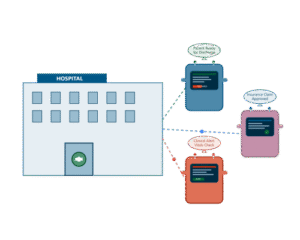Robotic Process Automation (RPA) has long been the backbone of business automation, streamlining repetitive tasks and improving efficiency.
But with Agentic AI and AI Agents being the talk of the town in past few months, some industry experts are questioning whether RPA is dead.
AI-driven systems now promise not just automation, but adaptability, learning, and decision-making, challenging the traditional role of RPA.
Is RPA truly outdated, or is it transforming to stay competitive in the AI era?
In this blog, we’ll examine the current state of RPA, explore its evolution, and determine whether it remains a key player in modern automation strategies.
The Evolution of RPA
Robotic Process Automation (RPA) gained prominence in the mid-2010s as businesses sought ways to streamline repetitive, rule-based tasks traditionally handled by human workers. The technology promised to reduce costs, minimize errors, and increase productivity by automating tasks such as data entry, invoice processing, and customer service interactions. Companies like UiPath, Blue Prism, and Automation Anywhere became industry leaders, driving significant adoption across various sectors.
According to a report by McKinsey & Company, RPA adoption surged from 13% in 2019 to over 30% in 2022, with a growing number of enterprises recognizing its potential to automate mundane tasks. The global RPA market size was valued at $18.41 billion in 2023 and was expected to grow at a compound annual growth rate (CAGR) of 25.7% from 2024 to 2033.
RPA’s Challenges and Criticisms
Despite its rapid adoption, RPA has faced several challenges. Some of the common criticisms include:
- Scalability Issues: Many organizations struggled to scale their RPA initiatives beyond pilot programs. According to Deloitte, only 3% of organizations have managed to scale RPA to more than 50 robots.
- Maintenance Burdens: The automation scripts created by RPA tools often require frequent updates due to changes in the underlying systems they interact with. This has led to higher-than-expected maintenance costs, diminishing the anticipated ROI.
- Limited Cognitive Capabilities: Traditional RPA is primarily rule-based, which limits its ability to handle complex, unstructured tasks. This has spurred the development of more advanced intelligent automation (IA) technologies, such as AI and machine learning, which can process unstructured data and make decisions based on it.
These challenges have led some to question whether RPA is still relevant in a landscape increasingly dominated by AI-driven solutions.
RPA in 2025: Is It Dead or Evolving?
According to Gartner’s latest report, “Robotic process automation continues to be a core software market for improving operational efficiency with tactical automation.” The report also predicts that by 2025, 90% of RPA vendors will offer generative AI-assisted automation to improve the customer experience. This integration is a critical evolution for RPA, as it addresses many of the technology’s previous limitations.
Generative AI, such as OpenAI’s GPT-4, can enhance RPA by enabling more sophisticated decision-making processes, natural language processing, and predictive analytics. For example:
- Improved Decision-Making: AI can analyse vast amounts of data to make informed decisions in real time, which RPA can then execute. This combination allows for more complex process automation that goes beyond simple rule-based tasks.
- Natural Language Processing (NLP): With NLP, RPA bots can understand and interact with human language, making them more effective in customer service roles and other communication-based tasks.
- Predictive Analytics: AI can predict future trends based on historical data, enabling RPA to proactively address potential issues before they arise.
The integration of AI into RPA is not just an enhancement but a necessity in today’s fast-paced digital landscape. Businesses are no longer satisfied with automating simple tasks; they want intelligent automation that can adapt to changing conditions and provide deeper insights.
Industry Adoption and Use Cases
Despite the challenges, RPA continues to be widely adopted across various industries. In 2025, RPA is far from dead; instead, it is being integrated into more comprehensive digital transformation strategies. Here are some examples of how RPA is being used today:
- Financial Services: Banks and financial institutions use RPA to automate processes like loan application processing, fraud detection, and regulatory compliance. According to a report, RPA could reduce processing times by up to 80% in certain financial tasks, leading to significant cost savings.
- Healthcare: RPA is used to manage patient records, schedule appointments, and process insurance claims. By automating these tasks, healthcare providers can focus more on patient care while reducing administrative burdens.
- Manufacturing: In manufacturing, RPA is employed to streamline supply chain management, inventory control, and quality assurance. It helps in minimizing errors and ensuring timely production schedules.
- Retail: Retailers use RPA to manage inventory, process orders, and handle customer inquiries. This not only improves operational efficiency but also enhances the customer experience.
These use cases demonstrate that RPA remains a valuable tool for businesses looking to improve efficiency and reduce costs. However, the most successful implementations are those that integrate RPA with other technologies, such as AI, to create more intelligent and adaptable systems.
What is Intelligent Automation?
Intelligent Automation (IA) is the next evolution of RPA, combining traditional automation with advanced technologies like artificial intelligence (AI), machine learning (ML), and cognitive computing. IA extends the capabilities of RPA by enabling it to handle more complex tasks that require decision-making, pattern recognition, and learning from unstructured data.
Unlike traditional RPA, which is limited to rule-based processes, IA can:
- Understand and Process Unstructured Data: IA can interpret unstructured data from various sources, such as emails, documents, and social media, allowing for more sophisticated automation.
- Learn and Adapt: Through machine learning, IA systems can learn from their interactions and improve over time, making them more effective at handling dynamic and unpredictable tasks.
- Make Informed Decisions: AI algorithms enable IA to make decisions based on real-time data, leading to more responsive and intelligent automation solutions.
By integrating these advanced technologies, IA offers a more powerful and flexible approach to automation, capable of transforming entire business processes rather than just automating individual tasks.
The Relationship Between RPA and Intelligent Automation
RPA is a foundational element of Intelligent Automation, but it is not the only component. In an IA environment, RPA works alongside AI and other advanced technologies to create more comprehensive automation solutions. For example:
- Cognitive Automation: AI enhances RPA by enabling it to understand and process natural language, recognize patterns, and make decisions based on data analysis. This allows RPA to handle more complex tasks that were previously beyond its capabilities.
- Process Orchestration: Intelligent Automation can coordinate multiple RPA bots and other automation tools to manage entire workflows, ensuring that processes are completed efficiently and accurately.
- Predictive Analytics: IA systems use predictive analytics to anticipate future trends and challenges, allowing businesses to proactively address issues before they become problems. RPA can then execute the necessary actions based on these predictions.
The integration of these technologies into an Intelligent Automation strategy ensures that RPA is not dead but rather evolving into a more powerful tool that can drive digital transformation across entire organizations.
The Future of RPA: Trends and Predictions
As mentioned earlier, the integration of AI into RPA is a major trend that will define the future of the technology. By 2025, it is expected that 90% of RPA vendors will offer AI-assisted automation. This will significantly enhance the capabilities of RPA, enabling it to handle more complex tasks and deliver greater value to businesses.
Some specific trends to watch in this area include:
- AI-Powered Decision-Making: RPA bots will become more autonomous, capable of making decisions based on real-time data and learning from their experiences.
- Enhanced User Interfaces: AI will enable RPA bots to interact with users more naturally, using voice commands, chat interfaces, and other forms of natural language communication.
- Predictive Maintenance: AI can predict when RPA bots might encounter issues or require updates, reducing downtime and maintenance costs.
RPA as a Service (RPAaaS)
Another emerging trend is the shift towards RPA as a Service (RPAaaS). Similar to other “as a service” models, RPAaaS allows businesses to access RPA tools and capabilities through a cloud-based platform. This approach offers several benefits:
- Cost Efficiency: Companies can pay for RPA on a subscription basis, reducing the need for large upfront investments in software and infrastructure.
- Scalability: RPAaaS platforms can easily scale to meet the needs of growing businesses, allowing them to expand their automation efforts without significant additional costs.
- Flexibility: RPAaaS providers often offer a range of automation tools, enabling businesses to choose the ones that best meet their needs.
According to a report by Grand View Research, the global RPAaaS market is expected to reach $12.1 billion by 2027, growing at a CAGR of 31.3% from 2023 to 2027.
Industry-Specific RPA Solutions
As RPA matures, vendors are increasingly offering industry-specific solutions tailored to the unique needs of different sectors. These solutions combine RPA with industry-specific AI models and data analytics tools to provide more targeted automation capabilities.
For example:
- Financial Services: RPA solutions designed for financial services often include built-in compliance checks, fraud detection algorithms, and other features that are critical to the industry.
- Healthcare: In healthcare, RPA vendors are developing solutions that integrate with electronic health records (EHR) systems, enabling seamless automation of patient data management and billing processes.
- Retail: Retail-focused RPA solutions often include features for inventory management, customer relationship management (CRM), and supply chain optimization.
This trend towards industry-specific solutions reflects the growing maturity of the RPA market and its ability to meet the diverse needs of different sectors.
Conclusion: Is RPA Dead in 2025?
So, is RPA dead in 2025? The answer is a resounding no. While traditional RPA may be evolving, the technology itself is far from obsolete. Instead, RPA is being integrated into broader automation strategies, enhanced by AI, and tailored to specific industries. The rise of Intelligent Automation, generative AI, and RPA as a Service all point to a future where RPA plays a critical role in driving business efficiency and innovation.
RPA is not dead; it is transforming. As organizations continue to seek ways to improve operational efficiency and stay competitive in an increasingly digital world, RPA will remain a vital tool in their arsenal. The key to success lies in understanding that RPA is no longer just about automating simple tasks—it’s about creating intelligent, adaptable systems that can drive meaningful change across the enterprise.
In conclusion, businesses that embrace the evolution of RPA and integrate it into their broader digital transformation strategies will be well-positioned to thrive in 2025 and beyond. Whether through AI-powered automation, industry-specific solutions, or the flexibility of RPA as a Service, the future of RPA is bright, dynamic, and full of potential. RPA is not dead—it’s just getting started.



